Heat injury is a common occurrence in sport and working dogs. If the early stages are identified and managed, further progression with potentially life-threatening consequences, can be avoided. Severe cases can result in chronic health issues including kidney failure and sensitivity to heat. Heat injury is so much more than an overly hot dog. This article strives to make you aware of the dog’s normal cooling mechanisms, signs of heat injury, treatment of heat injury, and preventive measures to help avoid the problem.
Normal temperature regulation –
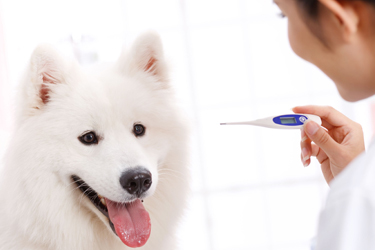
The normal temperature for a dog is 99-102 degrees, however an elevation to 107 degrees during work can be normal in a fit athletic dog for short periods. FOR SHORT PERIODS! This elevated temperature (hyperthermia) becomes a problem if the body loses its ability to compensate and cool itself in a reasonable time. The canine body uses several mechanisms to dissipate body heat. Panting increases air flow over moist surfaces in the oral cavity and upper respiratory tract for evaporative cooling. As the surfaces cool, so does the superficial blood which continues to circulate. Panting breaths are shallow and rapid – up to 300 per minute. The goal is to bring as much cooler air into contact with these surfaces as possible. There are runs of deeper breaths among the panting for improved oxygenation until the dog is in severe distress when this becomes impossible. The heat of the tissues is absorbed by the water content of the saliva in the mouth, and the water that covers the respiratory tract. As this water evaporates it carries the heat energy, releasing it into the environment. This is only effective if the gums are moist and the environment is not humid, i.e. saturated with water-filled air. When self-correcting via panting, dogs often dip their muzzles or heads into water, biting into it as they drink. This not only adds coolness, but increases the available water for heat transport.
Contrary to popular belief, dogs have sweat glands on their paws around the pads that assist in evaporative cooling. Some dogs learn to cool off by standing or splashing in water. The paws also take advantage of the radiation of body heat directly into the cooler environment. This explains the moist paw prints left on a cool floor by a hot dog. The radiation of body heat is much more efficient than the evaporative efforts of panting and occurs across the entire body. Dogs often take advantage of this by lying on concrete rather than grass on a summer day. It is with evaporative cooling that we can intervene the most actively and effectively in helping to cool a dog. Heat is energy and it always transfers from a warmer to a colder body or place. (With apologies to the physicists, I think we can leave it at that!) For radiant cooling to be most effective, the environment needs to be significantly cooler than the body and have low humidity.
Signs of heat injury –
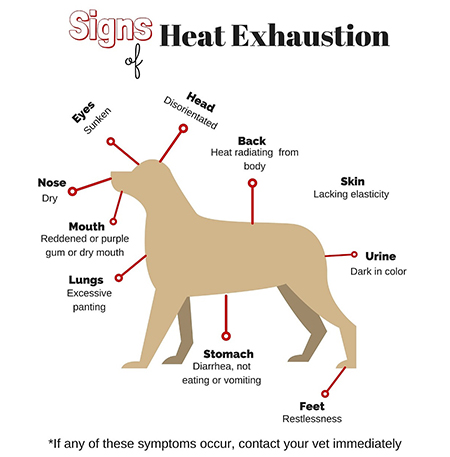
It can be difficult to notice early signs of heat injury in very high drive dogs, especially if you’re not looking for them. These dogs keep on going until they physically cannot, rather than being obvious about their stress. There are early signs, and you have to be careful and pay attention to your dog to be able to identify them. Some of the clues that your dog is getting overheated are described below in no particular order as each will worsen as the injury progresses:
1.) Shade seeking – We’ve all seen them take their reward into the blind’s shade, or even the handler’s shade. It means they need a break now, not after you run the blinds three more times. In a fit dog, this might mean a 10 minute break before doing the exercise again with the plan to do just enough that the session ends on a positive note. You can always bring him out again later.
2.) Slowing down – Whether running blinds for the fourth time or playing catch for fun. They may return to you slowly or incompletely because they know you will make them go again. As they move slowly, or stand to rest, they may literally sway on their feet as the condition worsens. Conversely, as a dog’s distress progresses, he may run in a disjointed (“spaced out”) manner without heed to his owner’s call – towards the last place he found water or coolness. At this point you should know there is a problem: glassy eyes, loud gaspy panting, ears may be folded in an unusual fashion.
3.) Excessive panting – The mouth opens wide and lips retract to expose more of the mouth’s interior to the cooler air. The gums and tongue progress from light pink to darker red as the saliva changes from copious clear liquid to a thicker white foam or paste-like consistency. The body’s drive to reduce the temperature does not allow the intermittent runs of deeper breaths so the body becomes starved for oxygen. When the mouth becomes dry, evaporative cooling does not take place. The muscular activity of non-productive panting increases the body temperature further.
4.) Incoordination (ataxia) – This includes components of both muscle fatigue and mental dullness. Heat injury in the later stages leads to a dog stumbling, leaning on objects to hold himself up, losing consciousness, and possibly seizuring.
Treatment –
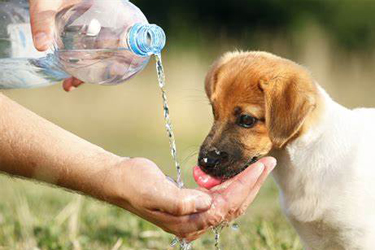
The most important aspect of treatment is rapid, effective cooling. Read that sentence again. The important words are “rapid” and “effective”. Be sure the dog has water to drink – small amounts are better than a large drink at once. Placing the dog in the truck with the AC going may be enough or he may need to be rinsed with a hose and placed before a fan to enhance air flow. Remember to rinse water in his mouth for improved evaporation – gently, we don’t want to choke him! If the animal is unconscious, the risk of choking is too great for rinsing the mouth. Immersing the dog in a pool is not as cooling as moving water over his body, but it will help. Focus water flow on areas where blood vessels are closer to the surface for heat radiation: abdomen, inner legs, head and neck. Major blood vessels are in the neck. This is a good place for ice, especially in males with a heavy ruff where water won’t be as effective. Play the water on his mouth and paws for evaporation. Take a rectal temperature so you have a starting point. It is important that your efforts do not allow the dog to become too cool. Once the temp drops to 103 degrees, relax your cooling efforts, the body will continue to cool a bit. Don’t forget to calm the dog as well; anxiety and stress can increase body temperature on their own. Check his temp every 5 minutes or so. If the dog is in severe distress, consider it a veterinary emergency. Crank up the truck and let the AC run while you cool the dog down with water, then put him into the cool vehicle for a ride to the vet. It is important in severe cases to have a veterinary evaluation. The dog may be dehydrated and in need of intravenous fluids or oxygen therapy. Severe heat injury carries the risk of kidney failure, irregular heart beats, shock, and cellular muscle destruction. One of the more common and most devastating consequences is disseminated intravascular coagulation, or DIC. This occurs when the high temperature damages the lining of the blood vessels causing malfunctions in the blood clotting mechanisms. Initially tiny clots are formed throughout the body, literally clogging the smallest vessels, leading to organ damage. As the body exhausts its ability to form clots, there is internal bleeding. Blood work can identify these problems as well as the early presence of DIC in time for potential treatment to be attempted. The internal damage done by a severe case of heat injury can progress for several days so your veterinarian might repeat some blood work. It is not uncommon for a dog that experiences a severe incident of heat injury to lose some degree of heat tolerance.
Prevention –
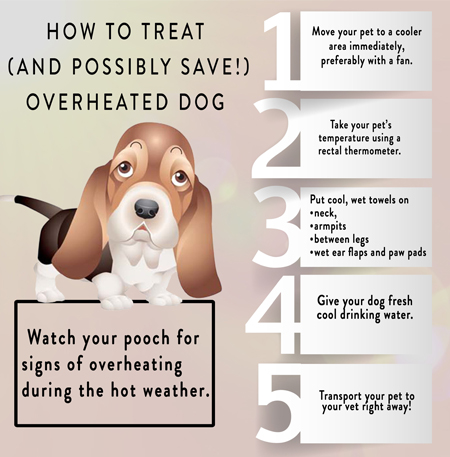
The good news is that there are many ways we can avoid heat injury in our sport dogs. Consider an average training weekend and how the following ideas can be put into play. When you show up to the club, the dog should have a fitness level equal to the demands of training. This is so important, and often overlooked. Schutzhund is hard! It is physically and mentally demanding of these dogs. Physical discomfort causes mental stress, and a dog that goes to train hard only on the weekends and ends up sore and tired every time, will not continue to be an eager partner. It has been shown in many species that stress inhibits learning.
Time must be allocated 3-4 days a week for conditioning. Jogging, hiking, biking, running alongside a horse, whatever works for you. The best way to build up conditioning for a certain task (barking, running blinds, long tracks) is to do that task, building up to longer times and farther distances. Six blinds on a regulation field is nearly a half mile run. Maximum points require the dog to be fast. Exercising and conditioning is a whole topic in itself, but get started on something! Your veterinarian should be able to offer suggestions or resources.
As the handler, it is your responsibility to stop when the dog needs a break. Don’t be afraid to stand up to a visiting coach and take care of your animal. The “She’ll run these blinds a dozen times till she gets it right!” attitude does not make you a good trainer. Knowing your dog is exhausted but continuing because you don’t want people to think you’re wimpy or your dog can’t do the work is foolish. Your dog needs your protection. New or young people to the sport need an example of how to treat their canine partners.
Consider how you arrive at the club. Driving to the field with the AC cooling the car to 45 degrees and unloading and going to train in 90 deg and 80 % humidity is very hard on the dog. The last 20 minutes of the drive, let the car warm up a bit. After the dog works enough to be hot on a really hot day, put him in the car with the AC running for 15 mins to help cool him down more rapidly. When you’re parked at the field, pay attention to shade, even if you have to park a little farther away. When the shade shifts, vehicles can be moved. Air flow is of prime importance. Open windows or even doors in the vehicle to find a cross breeze. You may have to pull the crate out of the vehicle to get some air flow. Covering the crates with a blanket because you haven’t taught your dog not to bark, makes it pretty stifling. Some commercial dog boxes that are used in truck beds have minimal air vents. Be sure you research before you select one. The argument that “I have to close him in or he’ll bark” is ridiculous and unsafe. Maybe you can park farther from the field. These dogs can be taught not to bark nonstop in their crates. Always bring more water than you need, and consider a fan to place in front of the crate. There are several on the market that run on batteries or the 10V plug in the truck.
During training, be sure to allow the dog to drink before and after work. In general, dogs drink when they need to – give them the opportunity. If they show early signs of heat stress, stop, cool them, give them water and a break. Even if they are just tired and panting heavily but not stressed, give them a break for a few minutes. As fitness improves, the dog’s need for rest breaks decreases. Just like the rest of us! When your session is over, don’t run back to the truck, close him in and go back to the field to watch. Walk him around a bit to radiate some body heat and cool down those muscles, offer him a drink, and make sure he’s OK. Most dogs that are panting heavily, will sit up in the crate to make breathing easier, but as they cool and panting decreases, they are able to lie down and rest. Try to figure out what is normal for your dog. Go back after 5-10 minutes and check on him if you’re concerned.
A common cause of heat injury is dogs left in closed cars. A former K9 officer shared the following preventive measure with me: If you leave your dog in a vehicle with the AC running, always leave windows down a couple of inches. If the vehicle quits running, hot air will rise and escape and the dog will be less likely to die. Working K9s die every year after they are left in a running vehicle with the AC on, because the engine stops.
This topic has particular importance to me because I had a GSD who is very sensitive to heat injury after a heat stroke at a young age. He suffers a moderate to severe heat injury an average of twice a year from chasing dragonflies or fence running. The symptoms I described earlier are from many observations of him as well as from veterinary client dogs. Needless to say, he spends summer days in the house if I’m not around to keep an eye on him – please don’t let this happen to you!
Happy Training, and more importantly Happy Play!

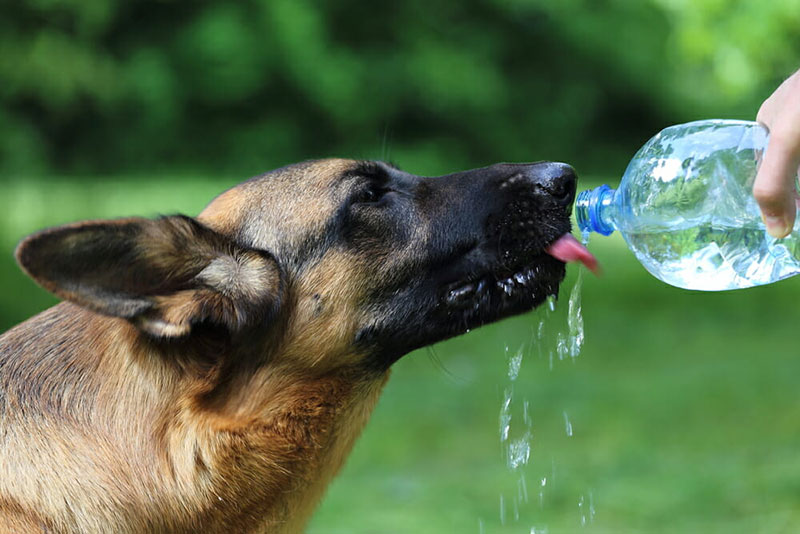
Recent Comments